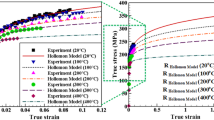Abstract
A study was undertaken to simulate the thinning behavior of titanium 6Al-4V alloy sheet during Superplastic Forming and to evaluate the feasibility of controlling thinning in areas of interest with Friction Stir Processing (FSP) of the material. The commercially available Finite Element Analysis software ABAQUS was used to execute these simulations. Material properties of the parent sheet and the Friction Stir Processed regions input into the models were determined experimentally by elevated temperature tensile testing. The results of these simulations were compared to experimental test results via Superplastically Forming representative aerospace parts and analytical computations for validation. It was found that numerical simulations can be used to predict the thin-out characteristics of superplastically formed titanium parts and the thin-out can be controlled in desired areas by FSP, locally, prior to forming.














Similar content being viewed by others
References
The Welding Institute, 20 February 2006, http://www.twi.co.uk/j32k/unprotected/band_1/fswintro.html
R.S. Mishra and Z.Y. Ma, Friction Stir Welding and Processing, Mater. Sci. Eng. R, 2005, 50, p 1–78
T.J. Lienert, Microstructure and Mechanical Properties of Friction Stir Welded Titanium Alloys, Friction Stir Welding and Processing, Chapter 7, ASM International, Materials Park, OH, 2007, p 123–154
M. Peel, A. Steuwer, M. Preuss, and P.J. Withers, Microstructure, Mechanical Properties and Residual Stresses as a Function of Welding Speed in Aluminum AA5083 Friction Stir Welds, Acta Mater., 2003, 51, p 4791–4801
Y. Li, E. Hood, W. Tang, and A.P. Reynolds, Friction Stir Welding of TIMETAL 21S, TMS Annual Meeting Proceedings, 2005, p 81–89
A.J. Ramirez and M.C. Juhas, Microstructural Evolution in Ti-6Al-4V Friction Stir Welds, Mater. Sci. Forum, 2003, 426-432, p 2999–3004
W.-B. Lee, C.-Y. Lee, W.-S. Chang, Y.-M. Yeon, and S.-B. Jung, Microstructural Investigation of Friction Stir Welded Pure Titanium, Mater. Lett., 2005, 59, p 3315–3318
A.P. Reynolds, E. Hood, and W. Tang, Texture in Friction Stir Welds of Ti Metal 21S, Scripta Mater., 2005, 52, p 491–494
T. Trapp, E. Helder, and P.R. Subramanian, FSW of Titanium Alloys for Aircraft Engine Components, TMS Annual Meeting, Friction Stir Welding and Processing II, 2003, p 173–178
D.G. Sanders and M. Ramulu, Examination of Superplastic Forming Combined with Diffusion Bonding for Titanium: Perspective from Experience, J. Mater. Eng. Perform., 2004, 13(6), p 744–752
G. Grant, Pacific Northwest National Laboratories, unpublished research
D.G. Sanders, “Development of Friction Stir Welding Combined with Superplastic Forming Processes for the Fabrication of Titanium Structures,” Ph.D. Dissertation Proposal, University of Washington, 2007
E.J. Klock-McCook, “Characterization of Friction Stir Welded and Superplastically Formed Friction Stir Welded Joints of Titanium,” Masters Thesis, University of Washington, 2005
P.D. Edwards, “Experimental and Numerical Characterization of Friction Stir Welded and Superplastically Formed Friction Stir Welded Titanium,” Masters Thesis, University of Washington, 2006
P. Edwards, Tensile Behavior Simulation of Friction Stir Welded and Superplastically Formed Friction Stir Welded Titanium 6Al-4V Alloy, ASME International Mechanical Engineering Congress and Exposition, 2007, Accepted for Publication
A.K. Gosh and C.H. Hamilton, Superplastic Forming of a Long Rectangular Box Section—Analysis and Experiment, Process Modeling, Fundamentals and Applications to Metals, T. Altan, H. Burte, H. Gegel, and A. Male, Ed., American Society for Metals, Metals Park, OH, 1979, p 303–331
Acknowledgments
The authors of this article would like to thank The Boeing Company for their support throughout this research project. Thanks are extended to The Edison Welding Institute for providing the welded specimens and Pacific Northwest National Laboratories for elevated temperature tensile testing of the base and weld materials.
Author information
Authors and Affiliations
Corresponding author
Additional information
This article is based on a presentation at the AeroMat Conference, International Symposium on Superplasticity and Superplastic Forming (SPF) held in Austin, TX, June 23-26, 2008.
Rights and permissions
About this article
Cite this article
Edwards, P.D., Sanders, D.G., Ramulu, M. et al. Thinning Behavior Simulations in Superplastic Forming of Friction Stir Processed Titanium 6Al-4V. J. of Materi Eng and Perform 19, 481–487 (2010). https://doi.org/10.1007/s11665-010-9608-2
Received:
Revised:
Published:
Issue Date:
DOI: https://doi.org/10.1007/s11665-010-9608-2




